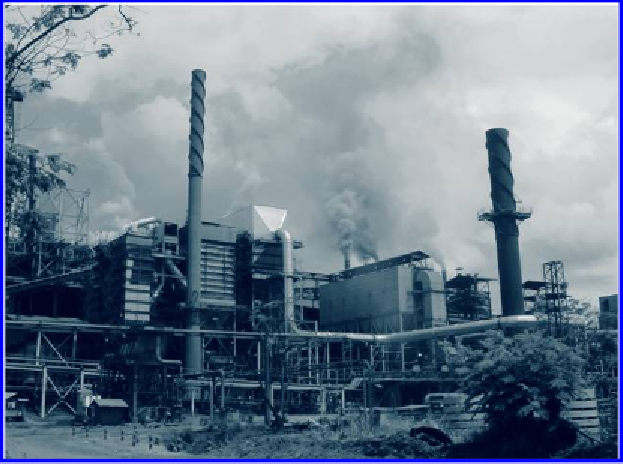Environmental Engineering Reference
In-Depth Information
FIGURE 13.8
Particulate Matter Emitted from a
Nickel Smelter (2006)
The profi le of air emissions sources
expands substantially if the mine
operation includes downstream
pyro-metallurgical mineral processing.
range of potentially harmful pollutants. Some countries still permit the use of lead addi-
tives in petrol and this generates an important air contaminant.
Stationary sources of air emissions in mining operations vary. Crushers and ore trans-
fer points are amongst the main sources of dust emissions. So are power stations at mine
sites which are typically the greatest sources of combustion emissions. The proi le of air
emissions sources expands substantially if the mine operation includes ore roasting, or
downstream pyro-metallurgical mineral processing (
Figure 13.8
). Smelters are large-scale
industrial operations, in which emissions control constitutes the main environmental chal-
lenge (Bounicore and Davis 1992, Corbitt 1993, USEPA 1996, Wirth 2000).
In principle, it is a simple matter to measure the amount of air pollutants emitted into
the atmosphere from a dei ned source such as a stack, a crusher, or a stockpile. However,
this is only relatively straightforward in the case of a stack or a vehicle exhaust; it becomes
more difi cult when considering diffuse sources such as wind-blown dusts. Wind-blown
dust can be generated from any disturbed land area which lacks vegetation: construc-
tion sites, areas for mining, active mining areas, stockpiles, and mine waste placement
areas. Tailings disposal areas, if dried, are especially prone to wind-blown dust - i ne-
grained tailings materials are readily eroded by wind, and may be transported over large
distances.
In addressing atmospheric pollution measurements of ambient air quality can be very
helpful, but they do not tell the complete story of how pollutants move and change in the
air. In the case of soil pollution, for example, samples can be taken and analyzed for the
presence of a pollutant. By testing enough samples at different depths and locations, a
relatively accurate picture of the distribution of the pollutant emerges. The pollutant gen-
erally stays in place, making it easier to i nd.
Dei ning atmospheric pollution is more difi cult. There are additional uncertainties
about how a pollutant is diluted, changed, or moved as it disperses into the air. Additional
uncertainties relate to the weather - wind, sun, and temperature. Also, as the air sample is
taken over a specii c time period, the concentration measured is the average concentration
over that interval. In sum the concentration of any air pollutant may vary widely, both
temporally and spatially in three dimensions.
In addressing atmospheric
pollution measurements of
ambient air quality can be very
helpful, but they do not tell the
complete story of how pollutants
move and change in the air.










Search WWH ::

Custom Search